| Jama Masjid, Chanderi | |
|---|---|
 | |
| Religion | |
| Affiliation | Islam |
| Reference no. | N-MP-127 |
Jama Masjid, Chanderi is a congregational mosque in Chanderi, in the Indian state of Madhya Pradesh. [1] [2] It is listed as a monument of national importance.
| Jama Masjid, Chanderi | |
|---|---|
 | |
| Religion | |
| Affiliation | Islam |
| Reference no. | N-MP-127 |
Jama Masjid, Chanderi is a congregational mosque in Chanderi, in the Indian state of Madhya Pradesh. [1] [2] It is listed as a monument of national importance.

The mosque has three domes, one over each bay. The prayer hall has eleven arched entrances, while the northern and southern arcades have nine each. [1] [3]

The Masjid-i-Jehan-Numa, commonly known as the Jama Masjid of Delhi, is one of the largest mosques in India.

The Moti Masjid is a 17th-century mosque inside the Red Fort complex in Delhi, India. It was built by Mughal emperor Aurangzeb, damaged during the Siege of Delhi, and subsequently restored by the British. Named for its white marble, the mosque features ornate floral carvings. It is an important example of Mughal architecture during Aurangzeb's reign.
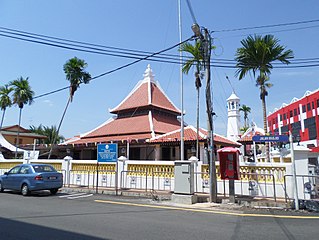
Kampung Hulu Mosque is a mosque situated at Kampong Hulu Village in Malacca City, Malacca, Malaysia. It is the oldest mosque in Malacca and among the oldest in the country, having originally built around the year 1720–1728 and underwent renovation in 1892. The architectural design of the mosque is a cross between Javanese Architecture, Local Malay, Sumateran, and Sini. The minaret, ablution pool and entrance arch were built at the same time with the main building. The minaret resembles a pagoda with the style of "Balai Nobat Melayu". An ancient cemetery lies next to the mosque in where some notable preachers and missionaries are buried.

Kampong Kling Mosque is an old mosque in Malacca City, Malacca, Malaysia. It is situated at Jalan Tukang Emas, also known as "Harmony Street" because of its proximity to the Sri Poyatha Moorthi Temple and Cheng Hoon Teng Temple.

The Jama Masjid of Bijapur is a congregational mosque in the Indian state of Karnataka. Initiated by Ali Adil Shah I of the Bijapur Sultanate in the 16th century, the mosque was never completed. It is the largest mosque in Bijapur, and has a capacity of 4000 worshippers.

The Jama Mosque is a 17th-century congregational mosque located in the historic core of Agra, Uttar Pradesh. It was built by Jahanara Begum, the eldest daughter of Mughal Emperor Shah Jahan, during the latter's reign. It is the principal mosque in the city of Agra, and lies close to Agra Fort.
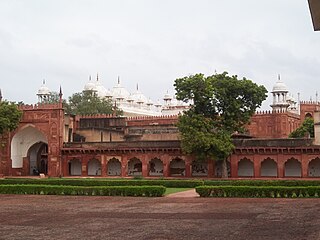
The Moti Masjid is a 17th-century congregational mosque located within the Agra Fort UNESCO World Heritage Site. Built by Mughal Emperor Shah Jahan, the mosque is made entirely of white marble.
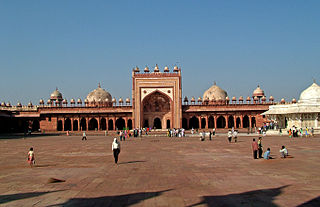
The Jama Masjid is a 16th-century congregational mosque in the UNESCO World Heritage Site of Fatehpur Sikri, located in Uttar Pradesh, India. It was built by Mughal emperor Akbar, and was the largest mosque in the empire at the time of construction. The Jama Masjid's design drew from earlier mosques built by various pre-Mughal sultanates, and served as an important precedent in subsequent Mughal architecture.

The Green Mosque, or the Mosque of Khawaja Abu Nasr Parsa is a mosque in the city of Balkh, northern Afghanistan. It contains the Shrine of Khwaja Abu Nasr Parsa. The mosque's name is derived from the kashi tiles on the walls of the mosque, which are coloured turquoise, known locally as Turkish Green.
Humayun Mosque is situated in the village of Kachhpura in Agra, Uttar Pradesh, India on the left bank of River Yamuna.

Jama Masjid or Jama Mosque or Jami Masjid or Badi Masjid, one of the largest Mosques in India, is a 15th-century mosque built by Hussain Shah Sharqi of the Jaunpur Sultanate in Jaunpur, Uttar Pradesh, India. It is one of the chief tourist attractions in Jaunpur. The mosque is 2.2 km north-northeast of Jaunpur, 7.3 km northwest of Zafarābād, 16.8 km north-northeast of Mariāhū, 26.3 km west-northwest of Kirākat. It is 1 km from the Atala mosque.

The Hassan Pasha Mosque, also referred to as the Pasha Mosque or the Grand Mosque, is a mosque located in Oran, Algeria. It was built in 1796 by order of Baba Hassan, Pasha of Algiers, in memory of the expulsion of the Spanish. During the French Invasion of Algiers in 1830, French soldiers would occupy the mosque during their invasion of Algeria as their living-quarters. 5 years after the French Invasion, in 1835, the building was established as a mosque and renovated three decades later. In 1952, the mosque was listed as a historic monument. Since 2010, this historic monument has been closed to the public.

The Menara Kudus Mosque or Al-Aqsha Mosque is located in Kudus in the Indonesian province of Central Java. Dating from 1549, it is one of the oldest mosques in Indonesia, built at the time of Islam's spread through Java. The mosque preserves the tomb of Sunan Kudus, one of the nine Islamic saints of Java, and is a popular pilgrimage point.
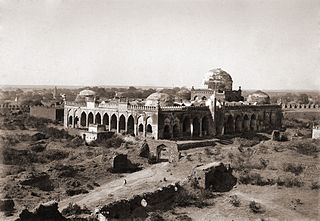
Jama Masjid Gulbarga or Friday Mosque of Gulbarga is a mosque located in Gulbarga, Karnataka, India.

Jama Masjid, also known as Jumah Mosque or Jami' Masjid, is a mosque in Ahmedabad, Gujarat, India. It was built in 1424 during the reign of Ahmad Shah I. The inscription on the central mihrab commemorates the inauguration of the mosque on the 1st Safar A.H. 827 or January 4, 1424 A.D. by Sultan Ahmad Shah I. The mosque lies in the old walled city, and it is situated outside Bhadra Fort area. The old walled city is divided into separate quarters or pols, and the Jami' Masjid is found on the Gandhi Road. Along the south side of the road, the mosque is a short distance beyond the Teen Darwaza or Tripolia Gate.
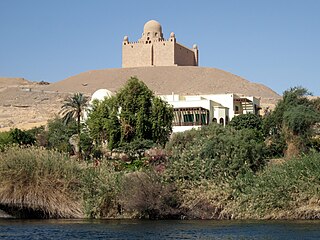
The Mausoleum of Aga Khan is the mausoleum of Aga Khan III, Sir Sultan Muhammed Shah, who died in 1957. The mausoleum is located at Aswan along the Nile of Egypt, since Egypt was formerly the centre of power of the Fatimids, an Ismaili Shia dynasty.
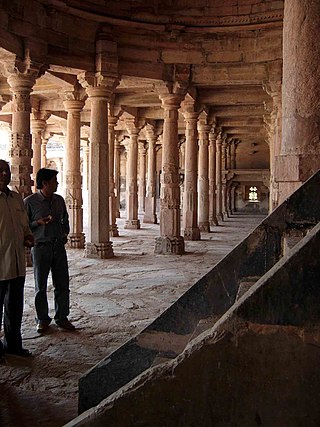
Lat Mosque is a mosque in Dhar in Madhya Pradesh, India. Named after the Iron pillar of Dhar, it is also known as Lat ki masjid, Ladh Masjid, or Lath Masjid.
Ram Nath is an Indian historian who specializes in Mughal architecture. He obtained a doctorate from the Agra University, and later taught at the University of Rajasthan. He is regarded as one of India's leading art historians.

The Zeenat-ul-Masajid, also written as Zeenat-ul-Masjid and popularly known as the Ghata Masjid, is an 18th-century Mughal mosque located in Delhi, India. The mosque was commissioned by Zeenat-un-Nissa, second daughter of the Mughal emperor Aurangzeb.

Bibi Ki Masjid, also known as Bibi Saheba Masjid is a mosque in Burhanpur, in the Indian state of Madhya Pradesh. It is listed as a monument of national importance.